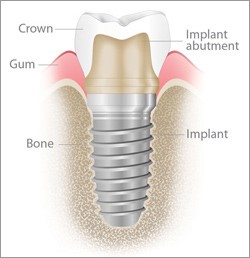Restorative dentistry
Fillings, Root canal treatment, and Implants
Fillings at Ellenbrook Dental Clinic
A filling is a way to restore a tooth damaged by decay back to its normal function and shape. When we provide our patients with fillings we first remove the decayed tooth material, clean the affected area, and then fill the cleaned out cavity with a filling material.
By closing off spaces where bacteria can enter, a filling also helps prevent further decay. Materials used for fillings include gold, porcelain, a composite resin (tooth-colored fillings), and an amalgam (an alloy of mercury, silver, copper, tin and sometimes zinc).
Which Type of Filling is Best?
No one type of filling is best for everyone. What’s right for you will be determined by the extent of the repair, whether you have allergies to certain materials, where in your mouth the filling is needed, and the cost. Considerations for different materials include:
Gold
Gold fillings are made to order in a laboratory and then cemented into place. Gold inlays are well tolerated by gum tissues, and may last more than 20 years. For these reasons, many authorities consider gold the best filling material. However, it is often the most expensive choice and requires multiple visits.
Amalgam
Amalgam (silver) fillings are resistant to wear and relatively inexpensive. However, due to their dark color, they are more noticeable than porcelain or composite restorations and are not usually used in very visible areas, such as front teeth.
Composite
Composite (plastic) resins are matched to be the same color as your teeth and therefore used where a natural appearance is desired. Composite fillings can also become stained from coffee, tea or tobacco.
Porcelain
Porcelain fillings are called inlays or onlays and are produced to order in a lab and then bonded to the tooth. They can be matched to the color of the tooth and resist staining. A porcelain restoration generally covers most of the tooth. They are hard wearing and look very natural. Their cost is similar to gold.
If decay or a fracture has damaged a large portion of the tooth, a crown, or cap, may be recommended. Decay and/or fracture that has reached the nerve may require a root canal treatment (in which the damaged and infected nerve is removed) prior to the final filling or crown.
How Do I Know if I Need a Filling?
Your dentist can detect whether you have a cavity that needs to be filled. During a checkup, your dentist will examine the surfaces of each tooth.
Anything that looks abnormal will then be further investigated.
Your dentist may also need an X-ray to confirm a diagnosis and formulate a treatment plan. The type of treatment your dentist chooses will depend on the extent of damage caused by decay.
Dental Implants
For those who want to replace a missing or broken tooth or multiple teeth, whether it’s recent or something you’ve been considering for years, dental implants may be for you.
Closing the Gap with Dental Implants
Have you ever wondered what your smile might look like if that missing tooth wasn’t missing? There are several ways to fill that gap with a “tooth” that looks and feels exactly like your other teeth.
 A dental implant is basically a screw with a crown. Dental implants never get cavities or need root canals!
A dental implant is basically a screw with a crown. Dental implants never get cavities or need root canals!
An increasingly popular way to restore missing teeth is through dental implants. These are used as an alternative to dentures and bridges.
Why?
Because they have many advantages, including their completely natural appearance, their convenience and their ability to maintain bone mass – a quality that makes additional tooth loss far less likely.
What Are Dental Implants?
Implants are made up of a titanium screw and a post that is covered with a crown, bridge or denture. We place the implant into the jawbone where it replaces the tooth root. After several months, the implant attaches to the bone, so it now looks and “acts” just like a natural tooth.
How It Works
You’ll come into our practice for a consultation, where we’ll discuss the suitability of dental implants with any other treatment options available to you. We’ll make sure you have a clear idea of the costs involved.
Then, if you choose to move forward, we’ll refer you to have a 3D scan of the bone area around the tooth space. This gives a complete look of where the implant will be placed, if there is the space required for it, and the measurements of the implant.
Each patient needs to be evaluated to ensure there is enough bone available to secure the implant. Impressions are taken to provide the necessary mold for a customized implant.
When you’ve made the decision to go ahead with the dental implant we will arrange for a surgery date.
*Any surgical or invasive procedure carries risks. Before proceeding you should seek a second opinion from an appropriately qualified health practitioner.
Want to Know More?
At Ellenbrook Dental Clinic we are always available to answer any questions you have about your dental health and the choices that are available to address specific conditions. If you’re concerned about missing teeth and your available options, or if you have any questions at all involving your dental health – feel free to give us a call. (08) 9297 1117
Root Canal
Getting to the Root Cause
Use the term, “root canal,” and many folks start shaking. “Oh no, anything but that!” So… when was the last time you had a root canal? Times have changed and so have root canal procedures.
Maybe you’ve been putting off a visit to Ellenbrook Dental Clinic because you fear you may need a root canal. Well fear no more and put your mind at ease by calling us to schedule an examination and a cleaning of your teeth. Let’s start there and see what we need to do. How’s that?
Why Would I Need Root Canal Therapy?
 Today’s root canals are nothing to fear!
Today’s root canals are nothing to fear!
Have you ever had an abscessed tooth? If so, you know the throbbing pain and swollen gums that go along with it and the inevitable trip to the dentist for what usually turns out to be a root canal.
In the not too long ago past, the term “root canal,” brought to mind painful images – but not anymore! Root canal therapy has definitely “grown up” into a far less fearful procedure and is no more painful than getting a tooth filled! In fact, the purpose of a root canal is to relieve pain, not cause it!
In very simple terms, a root canal removes infected tissue from the roots of the tooth beneath the gums. This is done to:
• Save the part of the tooth above the gums
• Minimize the risk of further damage
• Prevent loss of the tooth entirely, requiring more extensive and expensive treatment.
What’s the Procedure?
Depending on the severity of the infection, the dentist may prescribe an antibiotic for the infection prior to performing the actual procedure.
The root canal procedure then begins with the administration of a local anesthetic. Next, the dentist removes the damaged or infected nerve tissue and fills the infected root with an antibiotic to treat any remaining infection.
The tooth root is then packed with filling material. Finally, the tooth is capped with a crown to protect it, because of weakness and instability resulting from damage caused by the infection.
The entire process typically takes place over several visits.
Experiencing Pain or Need More Information?
If you are feeling moderate to severe tooth pain and notice swelling of your gums beneath the affected tooth, please call us right away and we’ll schedule an immediate appointment to get you out of pain fast.
Delay is dangerous in this case because the infection will continue to cause additional damage that could lead to tooth loss and the need for more serious and expensive treatment.
At Ellenbrook Dental Clinic, we are skilled in pain-free root canal therapy, so there is no need to put off treatment. We are here to help you get out of pain fast!

